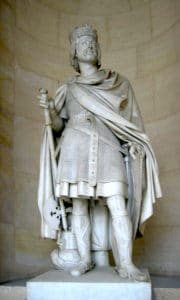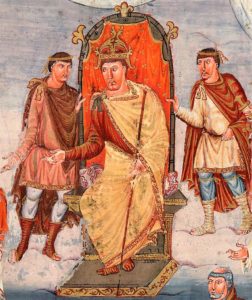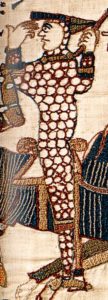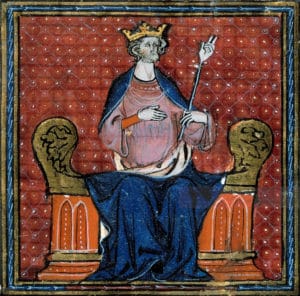The Franks embraced the Christian Gallo-Roman culture and ancient Gaul was eventually renamed Francia (“Land of the Franks”). The Germanic Franks adopted Romanic languages, except in northern Gaul where Roman settlements were less dense and where Germanic languages emerged. Clovis made Paris his capital and established the Merovingian dynasty, but his kingdom would not survive his death. The Franks treated land purely as a private possession and divided it among their heirs, so four kingdoms emerged from Clovis’s: Paris, Orléans, Soissons, and Rheims. The last Merovingian kings lost power to their mayors of the palace (head of household). One mayor of the palace, Charles Martel, defeated an Islamic invasion of Gaul at the Battle of Tours (732) and earned respect and power within the Frankish kingdoms.

His son, Pepin the Short, seized the crown of Francia from the weakened Merovingians and founded the Carolingian dynasty. Pepin’s son, Charlemagne, reunited the Frankish kingdoms and built a vast empire across Western and Central Europe.
Proclaimed Holy Roman Emperor by Pope Leo III and thus establishing in earnest the French Government’s longtime historical association with the Catholic Church, Charlemagne tried to revive the Western Roman Empire and its cultural grandeur. Charlemagne’s son, Louis I (Emperor 814–840), kept the empire united; however, this Carolingian Empire would not survive his death. In 843, under the Treaty of Verdun, the empire was divided between Louis’ three sons, with East Francia going to Louis the German, Middle Francia to Lothair I, and West Francia to Charles the Bald. West Francia approximated the area occupied by, and was the precursor to, modern France.

During the 9th and 10th centuries, continually threatened by Viking invasions, France became a very decentralized state: the nobility’s titles and lands became hereditary, and the authority of the king became more religious than secular and thus was less effective and constantly challenged by powerful noblemen. Thus was established feudalism in France. Over time, some of the king’s vassals would grow so powerful that they often posed a threat to the king. For example, after the Battle of Hastings in 1066, William the Conqueror added “King of England” to his titles, becoming both the vassal to (as Duke of Normandy) and the equal of (as king of England) the king of France, creating recurring tensions.

Late Middle Ages (10th–15th Century):
The Carolingian dynasty ruled France until 987, when Hugh Capet, Duke of France and Count of Paris, was crowned King of the Franks. His descendants—the Capetians, the House of Valois, and the House of Bourbon—progressively unified the country through wars and dynastic inheritance into the Kingdom of France, which was fully declared in 1190 by Philip II Augustus.

The French nobility played a prominent role in most Crusades to restore Christian access to the Holy Land. French knights made up the bulk of the steady flow of reinforcements throughout the two-hundred-year span of the Crusades, in such a fashion that the Arabs uniformly referred to the crusaders as Franj caring little whether they really came from France. The French Crusaders also imported the French language into the Levant, making French the base of the lingua franca (litt. “Frankish language”) of the Crusader states. French knights also made up the majority in both the Hospital and the Temple orders. The latter, in particular, held numerous properties throughout France and by the 13th century were the principal bankers for the French crown, until Philip IV annihilated the order in 1307. The Albigensian Crusade was launched in 1209 to eliminate the heretical Cathars in the southwestern area of modern-day France. In the end, the Cathars were exterminated and the autonomous County of Toulouse was annexed into the crown lands of France. Later kings expanded their domain to cover over half of modern continental France, including most of the north, center and west of France. Meanwhile, the royal authority became more and more assertive, centered on a hierarchically conceived society distinguishing nobility, clergy, and commoners.
